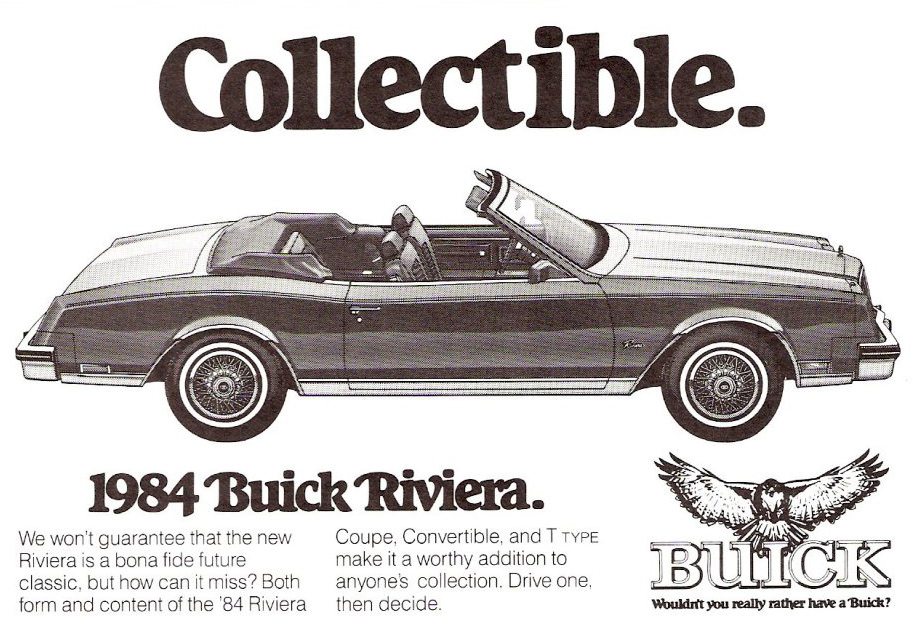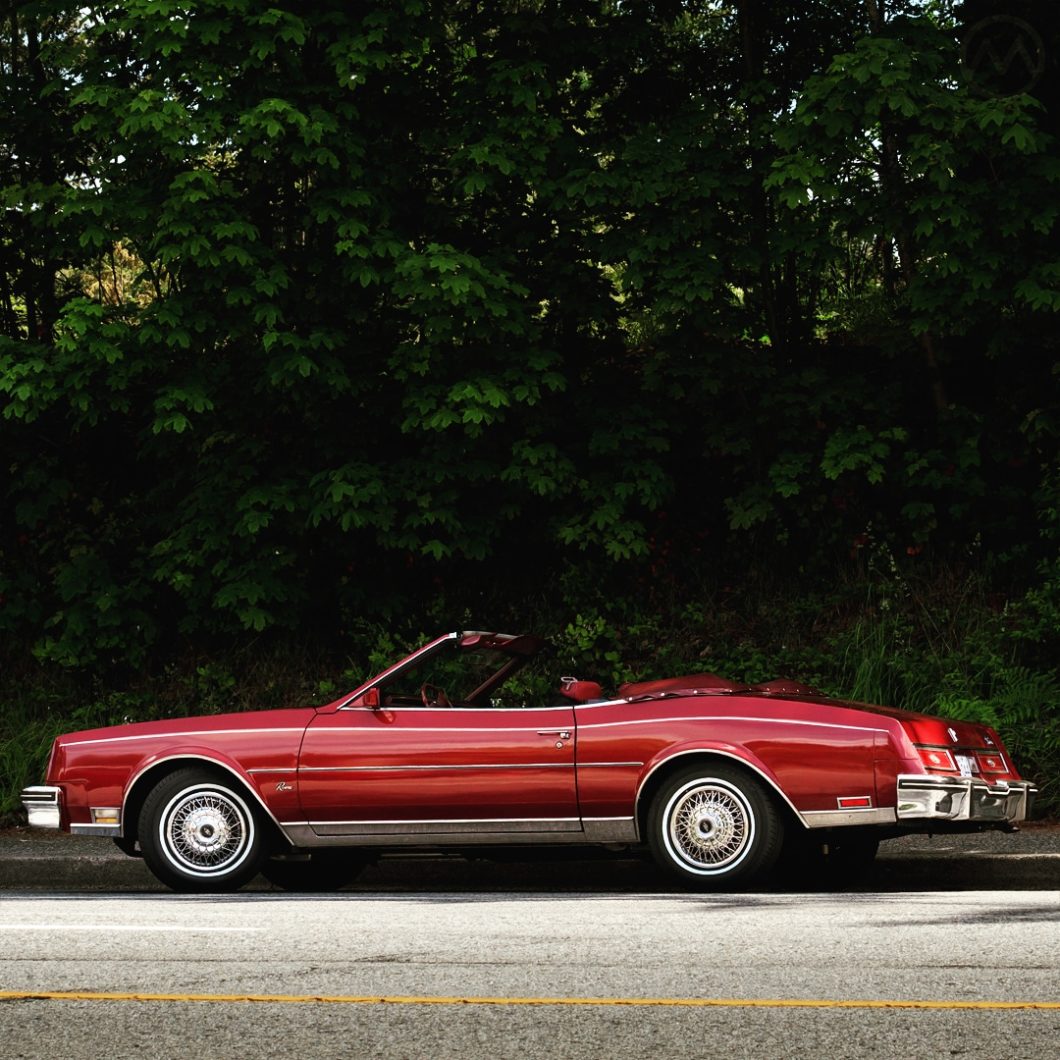American convertibles were dead, right? At least, they had been since 1976, when Cadillac hawked 14,000 Eldorado convertibles in one much-hyped last blaze of disco droptop glory. So no doubt parka-clad showgoers were surprised to see a brand-new American convertible – a 1982 Buick Riviera – on the stand at McCormick Place in February of that year.
As Michael Corleone would say, “Just when I thought I was out, they pull me back in.”
After the advent of cheap air conditioning in the 1960s, Americans had gradually abandoned convertibles to the point where their numbers no longer made financial sense from a production standpoint. One by one, existing convertibles were dropped in the 1970s as their production cycles wound down.
After the ’76 Eldorado the “factory” convertible was dead. But before it was buried a subset of customers stepped forward willing to pay big bucks to have privateers turn regular cars Al Fresco.
“Official” Vs. “Aftermarket”
From 1977-1982 independent coachbuilders, large and small, had supplied a variety of American droptops – a few of which were sold semi-officially by dealers. Examples of this breed included Cadillac’s Le Cabriolet (by Hess & Eisenhardt) and AMC’s Concord/Eagle Sundancer (by Griffith). They were, of course, fantastically expensive. The Le Cabriolet cost twice the donor Coupe Deville it was built on.
These cars were produced in tiny numbers and manufacturers offered only modest, if any, help in marketing them, not wanting to be associated with any questionable workmanship or liability concerns. Still, many were big-buck affairs and the profit in something like that couldn’t be ignored forever.
Into this environment stepped American Sunroof Corporation, then on the ropes after the 1980 recession.
ASC was founded in 1963 by German immigrant Heinz Prechter, then a student at Cal State who was finishing up his business administration degree.
Before heading to California, he’d been a student at the Georg Simon Ohm Polytechnic in Nuremberg. There he’d met Hans-Dieter Golde, son of the owner of Golde Schiebedächer, a maker of sunroofs and coachbuilt components in Frankfurt. In California, he was awarded Golde’s agency for the state and ASC was born.
ASC’s success eventually far outstripped Golde’s, and by 1967 the company was building sunroofs for many manufacturers on a semi-official basis. In the 1970s work progressed to custom cars and aftermarket modifications, and a second branch was opened in Detroit – Custom Craft, Inc.
Most of the “customs” ASC built at the time were Pimpmobile-type vehicles, customized Cadillacs and Lincolns that would have looked at home on the set of Superfly. In the T-top era, it engineered T-top systems for GM and other makers – including an expensive powered sliding-t-top setup for the Oldsmobile Toronado and Cadillac Eldorado – of which only Olds versions were produced.
The huge growth of ASC was dealt a sledgehammer blow by OPEC II and the subsequent economic fallout, and Prechter had to lay of about 70% of his employees in 1979-80.
One beacon of hope was creating a pair of 1981 Indy 500 pace cars for Buick. They were T-top Regals that the company then cut into convertibles with “basket handle” roofs, an arrangement that would later become very popular on 1980s convertibles and which Karmann debuted on a production car – the VW Golf Convertible, months earlier.
The pace cars established a relationship, and in casting around for ways to resuscitate ASC’s business, an idea was formed – what about building a full-on, big-buck customer convertible on a regular production line at ASC?
GM would not build such a low volume vehicle, but ASC had the spare capacity to build it at a lower cost than a specialist one-off coachbuilder, and it had the engineering expertise to make it work.
The 1982 Buick Riviera Convertible
There’s some debate over whether GM approached ASC about the idea or vice versa. However, ASC’s Mark Trostle Sr. (father of current FCA designer Mark Trostle, Jr.) later told the L.A. Times that Prechter and the rest of the ASC crew had fabricated the first Riviera on their own at their facility in Lansing, Michigan, and drove it down to Detroit to present it to division boss Lloyd Reuss (father of current GM President Mark Reuss) in late 1981.
The meeting led to a production deal. More than that, Reuss made it an “official” Buick model, marking the return of “factory” U.S. convertibles even if the “factory” wasn’t Buick’s.
GM would supply partly-finished Riviera Coupes, made in Linden, New Jersey, to ASC in Lansing. There the tops were cut off, the body strengthened, the power top installed and a modified interior put in with a new back seat.
To simplify things, the Riviera droptop was available in only two colors – White or Firemist (read: Metallic) Red. It came only with Claret (red) or Maple (brown) interiors and only with a white or red top.
ASC-built Rivieras would initially retail for about $24K – a $9K premium over the top Riviera T-type and $6,000 more than a Cadillac Eldorado. Shy of the Cadillac limousines, it was by far GM’s most expensive car in 1982, but still $14,000 less than a Mercedes SL.
Ahead of the A-pillar they were standard 1982 Rivieras, powered by a Buick 4.1L V6, an Olds 5.0L V8.
Hess & Eisenhardt had already done a very small run of 1979-81 Eldorados, as they’d done with the Le Cabriolet (based on the DeVille), but each cost around $40K.
It’s likely that H&E couldn’t make cars in the numbers GM might have wanted or make them to the cost target GM would have liked. H&E may also not have had any access to Reuss, dealing instead with Cadillac’s sales organization and management.
Whatever the reason, ASC’s proposal became a “factory” Buick. Production was limited to 1,248 cars for late-intro 1982, and many were snapped up quickly after cars belatedly began arriving in June – so GM upped the quantity to 1,750 for 1983.
Buick hadn’t been alone in wanting to do this, and it’s possible the speed of the Riviera deal had something to do with rumors about Chrysler’s team up with another Michigan converter, Cars & Concepts in Brighton.
GM Vs. Chrysler Vs. Ford
Chicago in the winter is exactly the wrong place to live with a convertible. Icy winds, snow drifts five feet high, and potholes that’ll make titanium creak. This was even more true in 1982, when the typical image of “convertible” was either a weathered MGB or a ‘71 Caprice and two successive mayors had been walloped by their poor responses to blizzards.
But there it was, a dazzling new Convertible, and you could place an order right then, but you couldn’t actually take delivery right away.
Two months after Chicago, Rivieras had yet to actually arrive at dealerships when Chrysler announced, and started delivering, the K-car LeBaron Convertible.
In early 1981, around the time ASC was building the Regal pace cars, Chrysler staffer Hank Carlini, a Lee Iacocca associate, had Cars & Concepts create a one-off Chrysler LeBaron convertible with wood paneled sides – reminiscent of Chrysler’s 1940s Town & Country convertibles. Iacocca, never one to miss an opportunity, approved $200,000 in tooling costs for it and ordered C&C to go full speed ahead on getting it ready to build.
It appeared a couple of months after the Riviera, but when it did it was ready to roll at the dealership.
It was smaller, but $10,000 cheaper and instantly sucked all the air out of the room as the “first” new American convertible since 1976. Ford followed with an even-cheaper droptop V8 Mustang in September. The Riv had gotten there first, but was too pricey and too slow to arrive in the showroom.
Having scaled up production for an anticipated demand in 1983 that did not come, 1983’s Riviera convertibles often languished on dealer lots. Still, the car did achieve the mission of reinvigorating ASC. By early 1983 it was knee-deep in convertible projects for Toyota and Saab, and more for GM.

With 1983 units still unsold, GM reduced production to 500 cars for 1984 and also began selling the related Cadillac Eldorado convertible from ASC – the exact same conversion done in the exact same way, since the cars were much the same underneath.
Buick also tried upping the Convertible Riv’s game by adding the Turbocharged 3.8L Buick V6, though only 96 were ordered over two years. This move was telegraphed by another ASC-built Pace car, this time for the ’83 Indy 500.
For GM’s trouble with the Eldorado conversion, it was rewarded with a lawsuit by disgruntled ‘76 Eldorado owners who claimed they’d bought their car on the assurance it’d be the last.
After a better 1985 outing, both convertibles were retired after the Riv and Eldo were unhappily downsized for 1986. 3,898 Riviera convertibles were made overall. Buick has only built two convertibles since – the short-lived Reatta (also from ASC) and the Opel-sourced, made-in-Poland Cascada.
GM, for its part, focused on cheaper convertibles shortly thereafter – on the J-car Cavalier/J2000 (engineered by ASC, but built at a real GM factory in Ohio) and F-body Camaro/Firebird.

